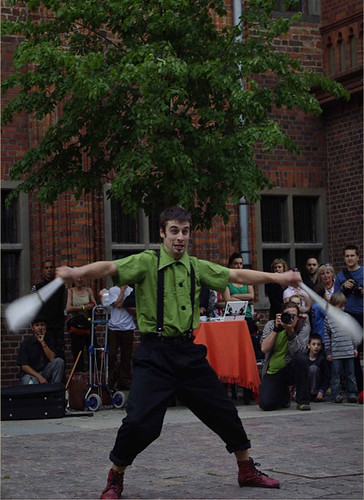We all know that Justin Bieber can (sort of) juggle and that Donald Rumsfeld used to ride a unicycle, but it’s been a while since a bonafide celebrity came forward with some serious circus skills. Enter Ellen Page. Yes, the Canadian-born Juno star has some pretty decent chops it seems, and isn’t afraid to show them off!
The latest new trick by Richard “Reeses” Kohut (creator of the Muffin Clutch).

I sure hope this works...

BULLSEYE!!!

Triumph!
It’s happened to all of us. If you’re reading this blog, then at one point, someone has called you a clown. Maybe it’s because of your habit of juggling during your lunch break. Maybe it’s because you ride your unicycle to work. Maybe it’s because your ringtone is “Entry of the Gladiators”. Someone has called you a clown, maybe even today.
Many accept it with a shrug. Others take it as a compliment. Some of us take serious offense. Alex on Facebook writes:
I’m terrified of clowns and therefore juggle in a tux. I cringe when people say I should go to the circus…
New York Juggler Paris (no last name), had the following to say:
As a juggler I respect clowns. We just want to be recognized for all our hard work. Police officers and firefighters have mutual respect but I imagine that a cop would be annoyed if you confuse him with a firefighter.
Keith Nelson, however, has a different perspective. Keith works as a clown and a juggler (among many other things), and was kind enough to share his point of view:
Just because someone can juggle does not mean they are a clown. Clowning takes years of pain and suffering in order to understand the inner workings of human nature, where as a juggler simply has to throw stuff in the air for fun, pleasure, and possibly a living.
Juggling takes practice, clowning takes living and suffering.
We want your opinion on the issue. Leave a comment below!
By TMJ Gossip Staff
Juggling magnate and high-profile man about town Brian Dubé was spotted with Jersey Shore starlet Nicole “Snooki” Polizzi at Jay Z’s 40/40 Club in Chelsea. Witnesses say the pair got a little bit frisky on the dance floor, enjoying Long Island Iced Teas and fist pumping the night away. When approached about the alleged encounter, Brian was not coy.
“She’s a wonderful girl,” the juggling kingpin said. “We’ve got a lot in common and she has a lot of interesting things to say.”
A spokesperson for Polizzi declined comment. The news of their relationship comes just weeks after fellow juggling prop maker Todd Smith was sighted attending a high-profile gala at Los Angeles’ Viper Room with Jenni “JWoww” Farley.
As children, many of us dream of being in the circus. That dream, however, can quickly become a nightmare. Many child circus performers in the third world are trafficked, abused and neglected. They aren’t willing participants in the circus show, but rather forced by unscrupulous circus owners in search of a fast buck.
Luckily, people are working to put a stop to this disturbing practice. The Esther Benjamins Trust is an organization devoted to rescuing exploited Nepalese child performers. The group works with local law enforcement to shut down circuses using illegal child labor. They also provide traditional schooling and professional circus training to the rescued performers, helping them develop the skills necessary to support themselves as they grow older.
Joaquín López, a Mexican-born clown and juggler, learned his craft the hard way. After making a living performing on the streets of Mexico City, Joaquín began travelling throughout Latin American, eventually settling in New York City. Although he enjoyed life in New York, Joaquín knew he had a higher calling. He soon left the cosmopolitan comfort of the big city to work with the child circus refugees of Nepal. Joaquín was kind enough to spend some time with us talking about his experiences.
Tell us about the children you’re working with. How did they get to your organization?
Some of the children that I worked with were victims of human trafficking. “Agents” convinced them to travel to India to get jobs in Indian circuses but most of the times they lived in very bad conditions. In some cases the families ask the organization for help to rescue this kids. After we rescue them, if the family doesn’t have the resources to take care of them, the organization provides a place to live, schooling, food and sometimes even a job. Others kids are street kids or victims of violence, even some of them were in prison in Nepal.
What is life like for the average child circus performer in South Asia?
I don’t have the answer to this question. What I do know is that in some Indian circuses they use child labor and not in a creative or artistic way. They teach the kids the skills in a mechanic way repetition and repetition, like robots. That is the reason that Esther Benjamins Trust created a circus company named “Sapana” to try to give the kids a new opportunity with the circus but this time in an artistic and creative way.
How is Nepal? Is it very different from the other places you’ve lived (Mexico City, NYC, Guatemala, Honduras, etc)
Is really different from other parts of the world that I’ve lived. The first difference and the biggest for me was the religion because it is everywhere in public life. The principal religion there is Hinduism and the second is Buddhism; many cultural traditions are mixed with these two religions. The most wonderful thing is that people practice both religions in peace.
What do you hope to achieve with these young people?
I hope that this new experience with the circus helps them in two different ways: help them to get a job so they become self sufficient and in the other hand, to take the negative experiences these children had in the circus and turn them into positive ones.
How do you think this experience has changed you as a performer and as a teacher?
Well, as a performer always is good to try different audiences. Some things that work for you with some people don’t work with others. So the experience was excellent to practice my improvisational skills.Because the people there speak Nepali I am required to communicate by unconventional methods. As a teacher, usually I am a social circus instructor so, the visit was perfect to increase my experience, to realize again that social circus is about more sharing and learning than teaching. Also the experience with these kids was awesome because they are very good kids with a very big heart. This was my big learning experience there, how to have the big heart that they have.
Click below to see a mini documentary on the Esther Benjamins Trust, including stunning images of a rescue operation and touching footage of rescued performers in action:
Telapayaso report. Nopal in Nepal from Kolectivo Que Da Alegría on Vimeo.
In the mid 1970s, Steve Mills, a young juggler from New Jersey, was creating quite a stir nationwide in the juggling community with his amazing skill set, even eclipsing seasoned long-time professionals. People were waiting for him in California at his first appearance at a national juggling convention.
I met Steve in 1975 at a free juggling workshop in the financial district of Manhattan. When I began to manufacture equipment for juggling, Steve became one of my very first customers and his use of my products and introduction to working professionals was instrumental in my early success. He came to the city to street perform as well as for the weekly workshop. I got to know him personally and as a Village resident, helped familiarize him with good spots for street performing, such as Father Demo Square and Washington Square Park.
One day, about that time, I received a letter that really stood out and which I still remember and often quote. It was a hand written order from a young boy in San Diego, California. He described the juggling clubs he wanted made with the size, weight, color and decoration scheme. But his real desire was made quite clear in one short sentence: “I want clubs just like Steve Mills.” Anyone familiar with idol worship can make the correct translation – “I want to be like Steve Mills.” Or perhaps more correctly “I want to be Steve Mills.”
I saw the same phenomenon close at hand in the 1980s when an employee of mine began to frequent all the hottest clubs in the city. She was a social butterfly with a serious case of celebrity worship syndrome. Because of her extensive networking, I was able to get into these clubs, all notorious for their difficult admission practices. It was through her that I also met Keith Haring and with whom we licensed his imaging for a new product line.
There are many analyses of the psychological mechanisms operating in the fascination and obsession with celebrities. We chase them, examine them, dissect them. We do it for inspiration, to fill a void or for entertainment. Medical research has found that the desire to follow the leader and become like them is programmed into our DNA. In some however, this can become an unhealthy obsession. One aspect I saw with my friend, was a belief that somehow, merely associating with celebrities would have their greatness or achievements rub off on them.
Of course this is illusion and delusion, because no amount of contact with super celebrities will bring you closer to their world or give you what they have. Skills, achievements and fame can not be transferred like electronic data, transfused like fluids via IV or absorbed through osmosis. I think I need to print a T-Shirt (and wear it myself) that says: Please Rub Off On Me, Just Like Steve Mills 
This article was first posted on Brian’s Blog www.NewYorkDailyPhoto.com, which he updates 5 days a week with commentary, stories, profiles and photos of New York City.
What do unicycles, testosterone and cellphones have in common? They’ve all been subjects of recent psychological and sociological studies, merging the worlds of monowheeling and science. One study, by Sam Shuster, a retired professor of dermatology, tests the public’s response to seeing a unicyclist in public and theorizes that testosterone levels have a lot to do with whether or not the response is positive or negative. Shuster notes that women often yelled out encouragement:
- “Wonderful… I am impressed”
- “Magic… it is magic”
- “You are an Olympic champion”
- “I wish I could do that. Oh that looks good”
- “That must need a wonderful balance”
Men however, were not so kind:
- “Lost your wheel?”
- “Hey do you know you’ve only got one wheel?”
- “I’ll look for your other wheel”
- “Couldn’t you afford the other wheel?”
This study proves two points that we already knew: 1) Men are jerks, 2) Most people aren’t that clever. While the study seems to state the obvious, some have been critical of the methodology. One prominent unicyclist, David Stone, called the study “terrible”:
Not much information, and many faults. It also didn’t compare the public’s reaction over a given time. I have ridden in NYC for 30 years and have seen some definite changes over that period. For sure, there is a component of reaction due to testosterone, as the writer of the study points out, but a heap of reaction is due to changes in social mores and demographics.
Another study, conducted at the University Bellingham, Washington, aimed to measure the level of distraction of cellphone users. Researches theorized that cellphone users have “inattentional blindness”, meaning that the brain doesn’t fully register what the eyes see. To test this theory, they sent a student researcher around campus in a clown costume riding a unicycle. As The New York Times explains:
“I was trying to think about what kind of distraction we could put out there, and I talked to this student who had a unicycle,” said Ira E. Hyman Jr., a professor in the university’s psychology department. “He said, ‘What’s more, I own a clown suit.’ You don’t have a student who unicycles in a clown suit every day, so you have to take advantage of these things.”
The study found (unsurprisingly) that cellphone users failed to notice the unicycling clown with the bulbous nose at an alarming rate.
Among pedestrians who were listening to music or walking alone, one in three mentioned that they had just seen a clown on a unicycle. Nearly 60 percent of people who were walking with a friend mentioned the clown. But among people who had been talking on the cellphone, only 8 percent spontaneously remembered the clown.
To anyone who’s been in public in the past 10 years, these results come as no surprise. I’ve conducted my own informal study regarding the attentiveness of pedestrians in New York City to unicyclists in the bike lane. My study concludes that pedestrians who talk on a cellphone and use the bike path as an extension of the sidewalk have a decreased awareness of unicyclists hurdling towards them:
As part of our partnership with El Circense, the Spanish language digital magazine, we will be republishing a selection of their original content, translated into English. This week, we present a short interview from the magazine’s “pass-pass” section with Santi Mutante, a young Argentinian artist. A multifaceted globetrotter that shares style and humor in each city that he performs.
By Fede

Photo by Antonio Vallano / Kuba
Who is Santi Mutante?
I’m a personal experiment, dedicated to getting better each day, giving the audience the best I can.
You are a multifaceted artist –clown, juggler, acrobat. Who were your formative influences?
I started theater classes when I was a boy taking free classes at the cultural center. I enjoyed acting, and then I took different clown workshops. Then I noticed that wearing a nose was stopping me from doing certain things and I didn’t want that. I always watched comedy in movies and on TV: Chaplin, the Marx brothers, Jerry Lewis, Dean Martin, Chespirito. I always admired Tato Bores and Olmedo in Argentina, and I think they taught me a lot. I started juggling in 1999 with Pablo Holgado. I was in every workshop that I could take, and I started to train with people that juggled seriously. I also studied at Videla Brothers’ Circo Criollo school where I was practing wire walking, unicycling and juggling. The best thing about being a tightrope walker is that I could mix it with other things that I love, like playing trumpet.
You were in Europe, what were you doing there?
I was performing my street show in Italy, and at some festivals in Spain and Poland. I also went to Barcelona creating and training for a new show with the company that I worked for in Mexico.
How was the experience of being in festivals?
Very different. Each festival is different from the other. I like working at festivals because the audience is very friendly. If you propose a game, the people know they are part of your show and understand that they can make the show great.
You work a lot in streets. How would compare the conditions with working in Europe?
Well, that is a complex question. It depends on everyting. Europe is very big and all the cities are different. Some places are better than others. Until you find a good place you can spend some time looking. Generally it’s good to work in summertime. There are lots of festivals, many popular parties, people who love circus and really respect what we do.
What is the difference working in Argentina, Europe or Mexico?
I’m more comfortable outside Argentina.
What is coming for the future?
I’m working in “Café Nostalgia” with my circus company in Mexico playing a character called “Sabandija.” It’s a new character I’m working on with subtle and wordless humor. I’m planning to research the part and continue acting in assorted variety shows.
Any message for the readers?
1. Think good ideas and rehearse.
2. Rehearse
3. Rehearse
For more information about Santi Mutante visit his website: www.santimutante.com.ar
Originally published November 2009.

Thank you to all our readers
March 19th marked the one-year anniversary of the Dubé Juggling Blog, and this is our 100th blog post! To commemorate the occasion, we’re running down the best (and worst) of the past year.
The story that got passions burning the hottest was the Fushigi Magic Gravity Ball. Brian wrote a satirical product review of the “Fishigi Ball” (something fishy is in the air). We also posted another Fushigi parody, the Bananashigi. On top of that, we wrote an editorial on the subject, titled “Fushigi, the death of contact juggling?”
We also met some interesting characters along the way. In September, we met Guillermo de la Kausa, a native of Peru who told us about his experiences as a Latin American street juggler. Last month, we met Yannick Foe, a native of Cameroon based in the conflict-stricken nation of Cote d’Ivoire. In August, we met Hyoga, a yellow Pokemonesque dragon based in Japan. Hyoga is a good friend of cigar box master Ryuhan.
We’ve talked about animals that juggle, robots that juggle and muppets that juggle. If it juggles, we’ll write about it.
We look forward to the second year of the Dubé Juggling blog. Thank you to all the readers who make this blog possible. We couldn’t do it without you.

With Japan still reeling from last week’s earthquake/tsunami/nuclear crisis, we decided to check in on our friend Ryuhan. Ryuhan, who is good friends with Hyoga the yellow juggling dragon, was kind enough to send us a message telling us know that he’s ok:
I’m OK, and my family too. However, many people lost their life, so we are very sad. And still, there are many aftershocks everyday, and the Fukushima nuclear power plant is serious situation, so we are very worry about it.
I’m not so near the danger zone (I’m live in Shizuoka, central Japan) no earthquake damage here. I hear some jugglers live in effected area, but most of my juggler friends are OK.
It’s great to know that everything is ok, but our hearts go out to those afflicted by the crisis.
Below, check out footage of Ryuhan Hyoga the juggling dragon in action:













